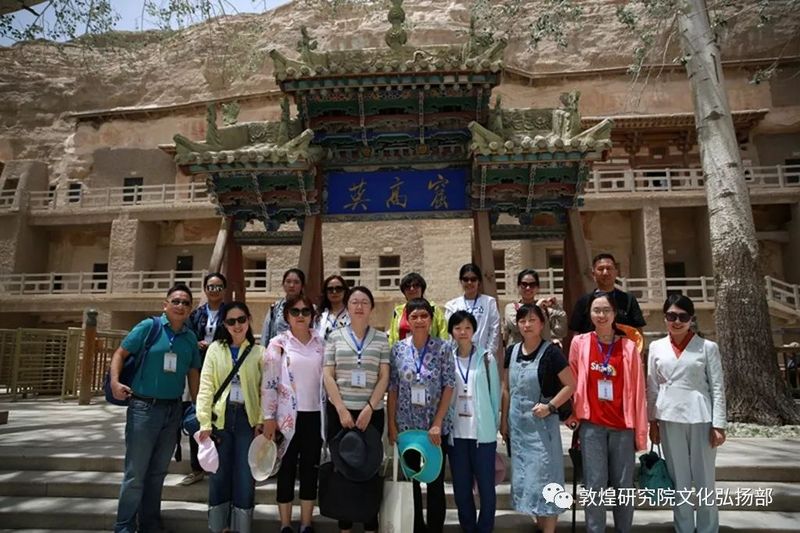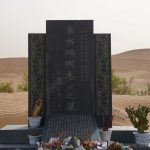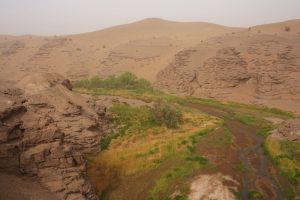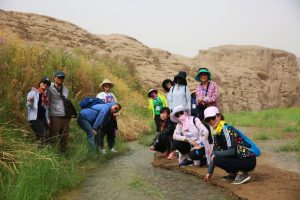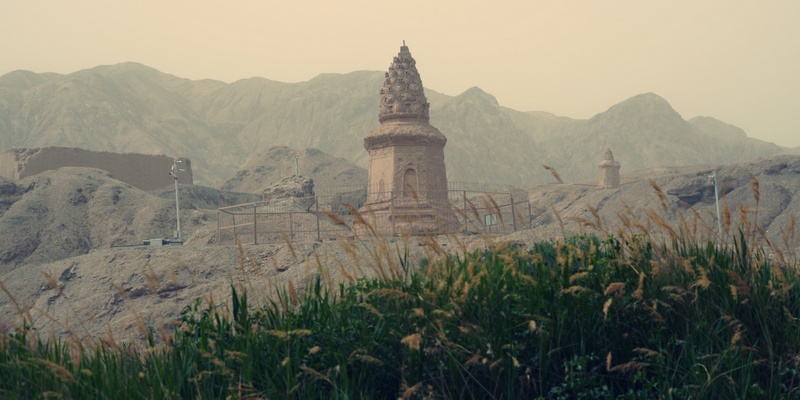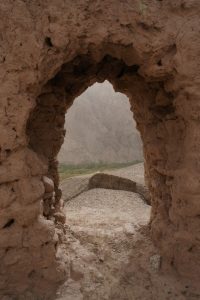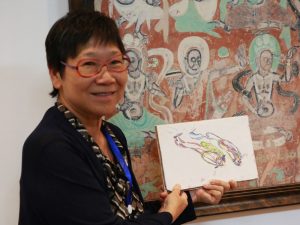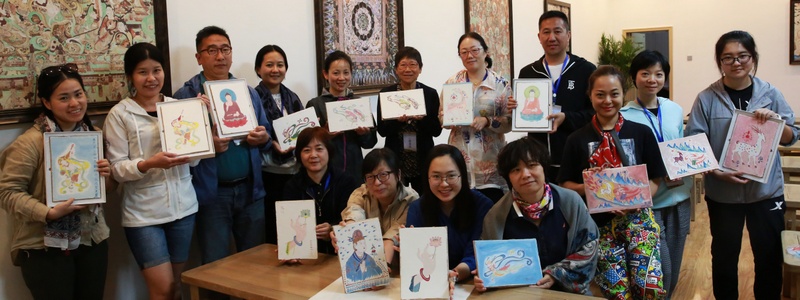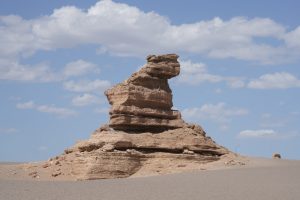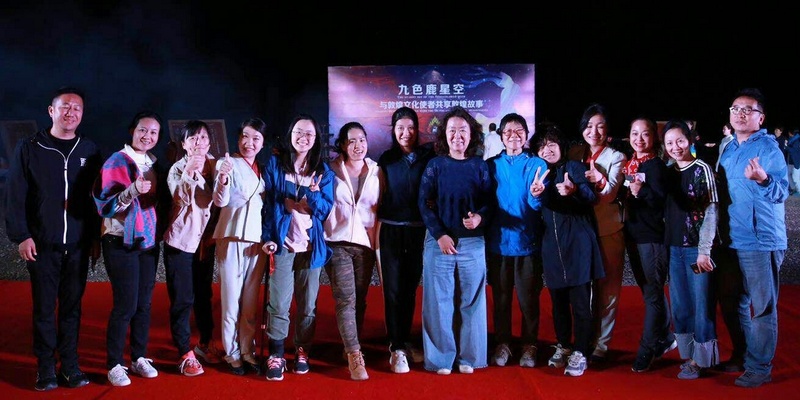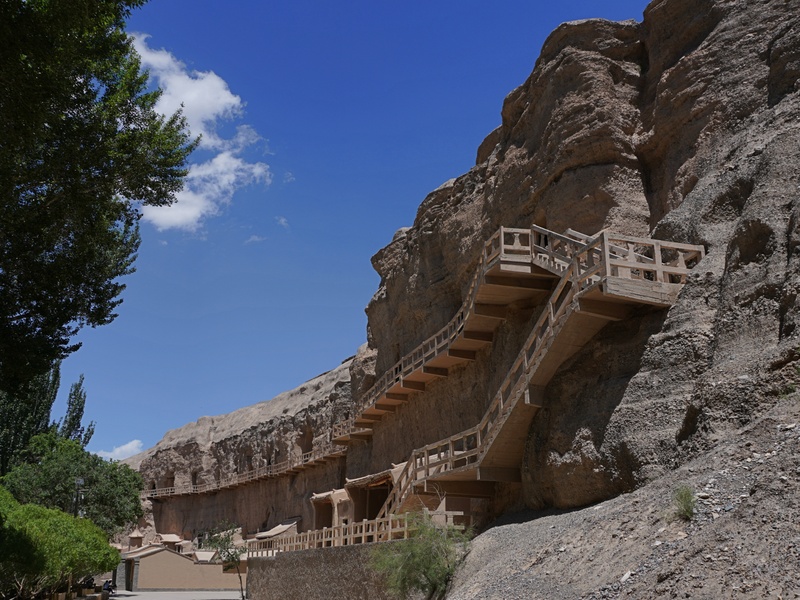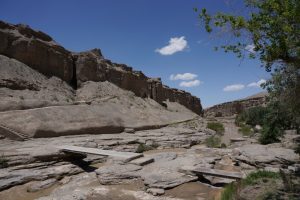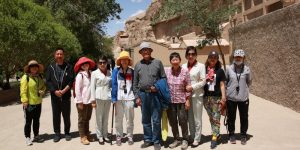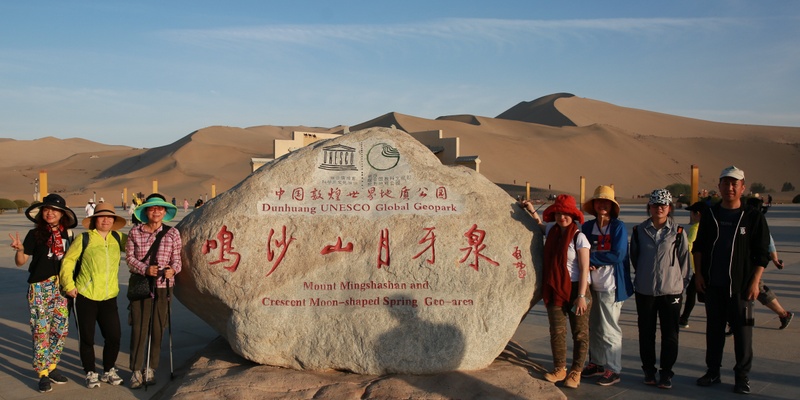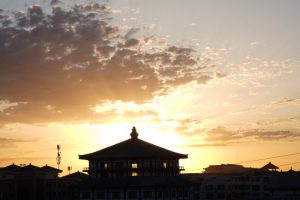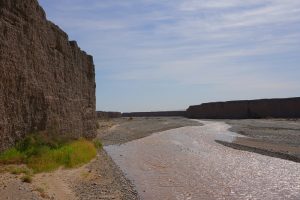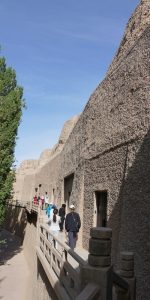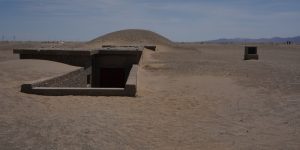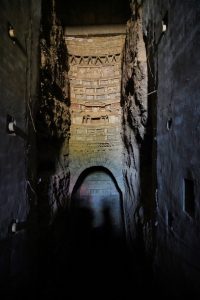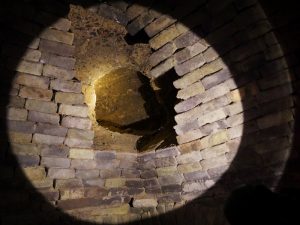Dunhuang (Mogao Caves & Yulin Caves) & Xi’an: June 10-18, 2019
8 Days in Dunhuang June 10-17
June 10 Sunday: Travel Day Xian – Dunhuang
As I get older, I prefer flights that fly after 10 am. I also try to avoid overnight flights as I cannot sleep. As a result, I paid more and flew to Dunhuang after 12 noon.
I took the 9:20 am airport bus from the long-distance terminal opposite my hotel. Though the fare is the same, it is troublesome to go through security before getting into the bus terminal. It is not surprising to few travellers bother to take it: the bus was almost empty with less than five passengers. Next time, I would take the shuttle bus instead.
I had a smooth flight to Dunhuang and arrived on schedule around 2:30 pm. At the airport, I met Xujun, a classmate from Wuxi. We had a transfer to the Hexi Corridor Hotel where I stayed last October. It’s like homecoming.
We were greeted by Ms Du, a staff from the Promotion Department of the Dunhuang Academy. We also met Ms Hu, our guide and minder. Both are soft spoken with a sweet voice and lovely smile. They said that there were five participants on the 3-day course and ten on the 6-day course.
I had a room on the sixth floor with views of the Danghe River and Ming Sha Shan. My roommate is Zhou, a young and cultured lady from Fujian. She was on the 3-day course as she had to go to Beijing for a musical performance.
At 6 pm, Du hosted a welcome dinner in the hotel. Out of the 15 participants, only five had arrived. I met a young girl from Shanghai who has just taken her high school examine. She had an accident a week before the examination and had to walk with a walking pole for three weeks. But she did not want to miss the course: her passion for learning and courage are admirable. We had a most sumptuous dinner and a few drinks. I felt at home and had a wonderful sleep.
Dunhuang Classroom (June 11 – 16)
The Dunhuang Academy is responsible for preserving, managing and promoting the World Heritage Site comprising the Mogao Cave, Yulin Cave and West Thousand Buddha Cave. The size of the class is limited to 30. The course is well-structured and packed with activities. Activities began around 8:30am and we often had lectures by researchers of the Academy in the morning and cave tour in the afternoon. In the evening, we had cultural programmes.
There are 735 caves in Mogao Caves. But only 70 are open to visitors: 40 caves are ‘open’ caves, 20 ‘adjust’ caves and ten ‘special’ caves (45, 57, 156, 158, 217,220,254, 275, 321 and 322) which requires payment of RMB200 for each cave per person. During this course, we would be seeing half a dozen special caves and some 30 ‘open’ and ‘adjust’ caves in Mogao. On Day 6 we would visit Yulin Cave.
During my 3-day trip in October 2018, I visited 15 caves in Mogao (including five special caves (45, 57, 158, 220 and 321) and ten open caves (16-17, 55, 61, 96, 328,329, 323,426 and 428). (Background information on the Mogao and Yulin Cave can be found in notes in October 2018)
Day 1 Monday (10 caves)
I met other participants on the bus. First, we were taken to Visitors’ Centre to watch two movies ‘A Thousand Years of Mogao Caves’ and ‘Splendid of Buddha’s Palace’ in the Digital Exhibition Centre. I did not watch these films last October 2018 as the allocated show time clashed with our guided tour. Anyway, I was not impressed by the first one which resembles a Hollywood film. The second one showing several digitalised caves is amazing and more interesting.
We had our first lecture by Liuyongzeng who gave an introduction on Dunhuang Buddhism art covering cave constructions in India, Pakistan, Afghanistan, Xinjiang region and Mainland China and how influences from these places had impacted on Dunhuang Cave. I am lucky and have visited most of the sites he mentioned except Bamiyan in Afghanistan. I bought his book online (RMB10) and had read a few chapters before his lecture.
Around noon, we had our first lunch in the staff canteen. The food is wholesome with little oil and salt. Perfect!
We spent four hours in ten caves in the afternoon (55, 61, 275 (special cave), 259, 257, 244, 96, 148, 285, 427 in that order). All are new to me except Cave 96 from the early Tang period with the 35.5m-high Maitreya Buddha.
After dinner at the staff canteen, we proceeded to the Aqua Blue Theatre to see ‘Encour Dunhuang’. I was told the construction of the purpose-built theatre and production cost amounted to RMB600million. I did not fall asleep this time and could follow the Putonghua monologue and singing this time. But I still find the presentation visually pretty but pretentious. I don’t think I would see this show for the third time.
Day 2 Tuesday (7 caves)
Our day began with a hike in the Gobi Desert along the river in front of the Mogao Cave. The river has dried up. We first stopped at the graveyard facing the cave. Only those who have made tremendous contributions to Dunhuang can be buried here. I saw the grave of Chang Shuhong (1904-1994), the first director of the Academy who played a pivotal role in establishing the Dunhuang Academy in 1943 and in safeguarding and preserving the invaluable treasures.
The 3km hike is wonderful. A dam has been built upstream. We jumped with joy when we saw vegetation upstream. We crossed the river to reach a ruin of the Xianyan Si, a temple of over a thousand years old. The ruin comprises a pagoda, a large enclosure resembling a former monastery and a rectangular structure half sunk below the ground.
We followed the river to return to Mogao Cave. I simply walked in the river which is nice and cool.
In the afternoon, we had a short tour to see seven caves (329, 328, 16-17, an exhibition hall (the former residence of Wang Yuanlu, the Daoist monk who found the library), 45 (special cave), 419 and 420). Though I have seen half of the caves (16-17, 45 and 329) last October, I learnt more about these caves as Du is an excellent guide.
I am glad Du took us to see the small exhibition hall opposite caves 16-17. Inside the hall, we learnt about the expeditions of the British archaeologist Aurel Stein in 1907 and the French sinologist Paul Pelliot in 1908. These two expeditions took with them some 40,000 manuscripts. The Japanese under Otani Kozui and the Russian under Sergei F Oldenburg arrived in in 1911 and 1914 respectively. In 1924, American Langdon Warner removed a dozen of murals as well as statues from the caves. Out of some 50,000 original manuscripts, only about 10,000 remain in China. The rest is scattered over 30 locations in the world though the majority is kept in the UK and France. When I saw the replicas in this hall, I was amazed at the beautiful paintings and art work.
We finished at 4 pm and returned to the hotel. Du arranged a sumptuous dinner for the group in the hotel before 6 pm. We arrived at Dunhuang Grand Theatre before 7:30pm with high expectations on Tam Dun’s ‘Buddha Passion’ which would be performed for the first time in Dunhuang. I paid RMB688 for a third-tier ticket.
The background of the music ic is moving. In 2013, Tam Dun, a world famous American Chinese composer and conductor, came on invitation of Fan Jinshi, the then head of Dunhuang Academy to see the caves. He was moved by the compassion, peace and tranquillity as manifested in the paintings. During a casual conversation, Fan Jinshi asked whether Tam Dun could compose a piece of music to tell world the stories and spirit of Dunhuang. After six years’ work, he finished composing ‘Buddha Passion’.
Tam Dun, the National Orchestra of Lyon and the International Choir Academy of Lübeck gave an excellent performance to an audience of 1,200. A few famous Chinese singers and a dancer also took part in the 100-minute performance.
‘Buddha Passion’ comprises six separate pieces which aspiration came from paintings in the caves. The first piece is related to ‘Under the Bodi Tree’; the second to the story of ‘Nine olour Deer‘ in Cave 257; the third on the story of ‘Thousand Eyes Thousand Hands’ in Cave 3; the fourth on Zen Garden in Cave 158; the fifth on ‘Heart Sutra’ and the last one on ‘Enlightenment / Nirvana’ in Cave 158.
It’s moving when Tam Dun told the audience about the origin of his composition and paid tribute to Fan Jinshi. He had a standing ovation of ten minutes.
Day 3 Wednesday (11 caves)
We had a lecture by Maqiang on ‘Revival of Traditional Art – Application of Dunhuang Elements in Today’s Creation and Design’. Ma talked about elements of Dunhuang art featuring feitian (flying Chinese apsara), lines, balanced design, free-flow and lively movements, use of colours from rocks and minerals etc. He illustrated how he and other artists have applied the Dunhuang art, colours, patterns and designs of costumes and canopies etc in their creations. He showed us examples of Dunhuang design as appeared in public space and buildings, costumes, lamps, pottery etc.
The weather had been veered with signs of a sandstorm. When we came out of the lecture room, the sky already turned yellow. We had to put on our mouthpiece. When we were driving towards the Mogao Cave, we saw coaches leaving. Then we learnt about the closure of the cave as sand could cause severe damage to the paintings inside the cave.
Anyway, we proceeded to have lunch at the staff canteen. The wind was still howling. It was my first time to see a sandstorm in a desert. As we could not visit the caves, Du arranged us to see the Art Museum with several replica caves.
We enjoyed looking at replicas of Mogao caves 275, 249, 286, 419 and 276, 217 and 003 and Yulin cave 29. We also went to the bookstore which stayed open because of us. I like feitian so much that I bought a book written by Liuyongzeng on the subject with lots of nice photos.
As the sandstorm had subsided, Du made special arrangement for us to continue with our cave tour. We saw 11 caves (203, 208, 209, 237, 249, 72, 57 (special cave), 290, 296, 332 and 335 in this order). Out of these, all are new to me except cave 57.
After dinner, we had two hours at a workshop on mural painting. I had a sketch of two delicate feitian of Tang Dynasty. I tried to paint but failed to bring flair and life to these beautiful creatures. I have no talent and my stroke is too heavy. By the time we finished and returned to the hotel, it was about 10:30 pm. A long day!
Day 4 Thursday; Excursion to Yardan National Geopark
Sunzhijun an accomplished photographer gave an excellent lecture on Dunhuang, the Mogao Cave and the Gobi Desert from a geo-history perspective. We also learnt about the developments of the surrounding area. His photos of the desert especially the sandstorms, sand dunes and vegetation are most impressive.
We had an early lunch and departed before 12:30 pm for Dunhuang Yardan National Geopark 敦煌雅丹国家地质公园 which is about 180km from the city. The geopark is the largest in China covering an area of 400 km2. Unique geological features have been created as a result of erosion of earth’s surface by wind and rain.
It took three hours to reach the park. We had to take a shuttle bus which makes four photo stops. At the first two sites (a lion and a pyramid), we only had 10-15 minutes to take photos by the road side.
We had the longest stop at the ‘Peacock’ site. It’s nice to be able to walk about 200m to take a closer look at a formation.
The last site is called the Yardan Ghost Town which offers the most expansive and magnificent views of the landforms.
On the way, we saw the Yumen Pass from the bus.
In the evening, we attended a special event called ‘Nine Colour Deer Star Sky’. It was organised by the Promotion Department of the Academy. We had mutton skewers and curry rice.
The main purpose of the evening was to get together with staff of the department. Ms Liping, head of the department and accomplished Japanese-Chinese translator, is warm and impressive. She has worked here for over 30 years. Three young ladies shared their stories of how they joined the Academy and their mission in promoting and preserving the treasures. I am moved by the passion, mission and team spirit of the Academy.
One of our classmates, a teacher from Shenzhen also shared her Dunhuang story. She had bought a group of her students to Dunhuang last year. She was moved when Dunhuang staff had gone out of their way to help her students who were hit by freezing weather. She is determined to bring more students to Dunhuang in future.
Some staff sang for us. We danced around the fire and did not leave till 11:15 pm. Another long day!
Day 5 Friday (9 caves)
Today’s speaker was a young scholar Shaoxuecheng, who talked about ‘To Go Forward from Dunhuang: Towards Bamiyan and Gandara’. His field of study is Bamiyan, Buddhism and Gandara art. He talked about Gandara art which flourished in Peshawa and SWAT valley in Pakistan and how it spread to Afghanistan and later Xinjiang and Mainland.
His talk is thought-provoking. I learn from him that the biggest cave cluster in the world is in Bamiyan which has sadly been ruined. The styles of Chinese Buddhist art and Dunhuang have closer resemblance to those in Bamiyan than Gandara.
Following the blast of the two giant standing Buddha statues (built in 6-7th centuries) by Taliban in 2001, it accidentally provides a unique opportunity to unearth the hidden history of the caves. The Dunhuang Academy is now assisting the Afghans to restore and preserve the caves. Du gave us a book written by a Japanese scholar Akira Miyaji (1996)and translated by Liping which explored the origin of Buddha image and statute. It is fascinating reading.
In the afternoon, we visited caves 397, 401,407, 409, 334, 23,71, 217 (special cave) and 203, all of which are new to me.
Tonight, Du arranged the class to see a cultural performance in the Grand Theatre. As I have seen it last October, Du kindly arranged me and a couple from Guangzhou to see an outdoor performance instead. We sat on a platform which turns 360 degree so that we saw five different scenes without moving at all. The lighting and scene settings are impressive. But the story line and singing are so-so. By the time I got back to the hotel, it was close to 11 pm again.
Day 6 Saturday: Yulin Cave
A study tour of the Mogao Cave would not be complete with seeing the Yulin Cave which are located some 150km east of Dunhuang. Last October, I visited Yulin for the first time and spent over three hours in seven caves (special caves 2, 3, 4 and 25; and general caves 6, 9 and 11).
This time, only six out of the ten classmates took part in this side trip. As usual we left the hotel at 8 am and arrived two and a half hours later. As special cave 3 was covered by the course fee, we all paid RMB400 to see special caves 2, 4 and 25.
I love Yulin which is tranquil and leafy. This time, it looked even more exquisitely beautiful: the Yulin River was fast flowing after heavy rain recently. I took photos and sent them to my buddies!
We had a very soft-spoken male guide who is gentle and knowledgeable about the caves. We began the tour with the general caves and saw 11, 12, 13, 14, 16 and 17 before lunch.
A new canteen has open since my last visit. We had noodles, pig feet and vegetables for lunch. I was not hungry and had noodles and vegetables which were delicious.
In the afternoon, we visited the four special caves. Though I only saw them seven months ago, I found it fascinating to see the paintings again.Of the nine caves I saw today, five were new to me. We left after 3 pm.
No visitor to Dunhuang should leave without visiting Ming Sha Shan, the sand dunes and the Crescent Spring. We therefore had a snack before going into the park. The sun was setting and we were given over two hours’ free time. Some planned to take a camel ride while others wanted to climb the sand dune to watch sunset.
As I had climbed the sand dune last October, I gave it a miss. Instead, I strolled leisurely near the Crescent Spring and took photos of moon rise over the sand dune and the reflection of the moon in the spring.
We met up at the exit after 10 pm and returned to the hotel. It was almost 11 pm when I found my way to my room. I started packing as I would leave the hotel at 8 am the next day.
June 17 Monday Dunhuang – Xi’an
My plane would depart for Xi’an after 3 pm. Hence, I had a morning for sightseeing. My classmate Xujun would be taking the same flight. We therefore hired a taxi for the morning and visited three attractions.
We first went to the West Thousand Buddha Cave 西千佛洞 hewn on a cliff side beside the Danghe River 35km southwest of Dunhuang.
The cave had served as a staging post for travellers on the Silk Road. It is the western counterpart of the Mogao Cave but is much smaller in scale with 22 caves. The area is leafy, quiet and lovely with few visitors.
The entrance fee is RMB30. Nine well-preserved caves are open to visitors. We followed a group tour visiting Caves 4 (Sui), 5 (early Tang), 9 (West Wei), 11 (Northern Zhou, a Zen practice place) and 18 (Tang).
The paint in the caves is still in good conditions. In the centre column of Cave 5, the guide showed us handwritings of some 70 words of Northern Wei which have high historical value. The blue colours and musical bodhisattvas of Northern Wei are stunning. It is said that most spectacular murals are located in Cave 15 which is a special cave.
Our next stop was ‘Old Dunhuang’, a film location built by the Japanese when shooting the film ‘Dunhuang’ in 1987. The Japanese are perfectionist and had built the old city after laborious research. The local government subsequently requested the Japanese not to demolish the structures. Today, it is a popular tourist attraction.
Our final stop was the a 1700-year-old nobleman tomb from the Western Jin (266-316). The grave lying some 13m below ground was dug up by tomb raiders in 1982. It is modest in size but shows how it had been constructed.
The brick walls are still in good condition. Mural paintings of mystical animals are still visible. Inside the tomb where the nobleman and his wife were buried, there is a wall painting with a pair of parrots. The colours are vivid. It is interesting to see a kitchen and a toilet attached to the tomb.
It was after 1 pm when we came out of the tomb. We had a quick lunch before the driver dropped us off at the airport. Xujun who runs his own company which designs and construct gardens, is a nice young man. He insisted in treating me. I can’t thank him enough for his kindness and generosity. I hope I can reciprocate one day when he comes to Hong Kong.
Our plane took off on schedule. I said good-bye to Xujun after landing in Xi’an as he would take a connecting flight to Wuxi. As I would be taking an early flight to Hong Kong, I decided to stay near the airport. A lady at the airport information desk found me a modest room (RMB158) in a local inn located 2km from the airport. The inn owner picked me up. Though I found the room not too clean, I did not make a fuss. Anyway, I had my sleeping bag liner and towel.
I strolled around the area which has a rustic village feel. There must be some 20-30 guest houses. I guess it was built to settle farmers whose land had been resumed for the construction of the airport. There is a street with food stalls which reminds me of the night market in Dunhuang in the 1990s.
After dinner, I stayed in my room reading the book on flying Chinese apsara and writing my travel notes. I had an air-con room and was able to have a decent sleep.
June 18 Tuesday: Xi’an – Hong Kong
The owner of the inn told me to take a ride to the airport at 7am. Though my flight would not be leaving till almost 10am, he insisted I should go with his other guests.
Unfortunately, I could not check in till 8:30 am. Luckily, the airport is spacious and the waiting lounge is comfortable. The plane took off on schedule and everything went well till 12:30pm when the pilot told us that we would begin descending to Hong Kong soon.
A few minutes later, the pilot said there was congestion and the plane had to hover around for 20 minutes. I noticed something was not right: the plane was heading somewhere!
By 1:30pm, the plane was still cruising. The pilot suddenly announced that we would be landing in Xiamen. What had happened? What next? It was frustrating: the pilot did not give any explanation. We were told to stay on the plane while it was refuelling.
Around 4 pm, the pilot said that we would be leaving soon. Where? Later, we were told that the flight to Hong Kong would take an hour and twenty minutes. I prayed I would land in Hong Kong safely this time.
We were served a glass of water during the entire fiasco. This is the second time that I was flown to a different airport without prior warning in China. After wasting four hours, I finally touched down in the Hong Kong airport around 5:30 pm. What a dramatic way to end my journey!
Remarks (written and uploaded on May 7, 2020)
Despite my previous trips to Xi’an and Dunhuang, I find my recent visit to both places a pleasant surprise and most rewarding.
First, Xi’an is an ancient capital rich in history and culture. Out of the six World Heritage Sites in the area. I have to find time on my next visit to see the four properties that I have not visited yet namely Weiyang Palace of Han Dynasty, the Daming Palace of Tang Dynasty, the Small Wild Goose Pagoda and the Xingjiao Temple which has preserved the relics of revered Xuanzang. There are many temples and museums worth visiting too.
Second, Xi’an has changed a lot since my last visit in the late 1990s. I like the airport shuttle service which is efficient and frequent. The metro is new, modern, clean and user-friendly. I have taken the bus too. I like the city which is green and leafy with a relaxing feeling. As it is very hot in the summer, I notice an underground tunnel/space is open for locals to escape the heat. I have eaten in a few local eateries around the train station. They are clean and the food is cheap and delicious.
Third, the 6-day course organised by the Dunhuang Academy is excellent. I am delighted to meet Liping, Head of the Promotion Department of the Academy and am impressed by the enthusiasm and dedication of the staff of the Academy. I fully appreciate the efforts made by our minders Du and Hu and our photographer Lu to make sure the course run smoothly.
I have learned more about Dunhuang, the Buddhist art history in general and in China in particular and the significance of the Silk Road. I find the lecture by Sunzhijun and Shaoxuecheng inspirational. Shao’s research on Bamiyan and its influence on Dunhuang is interesting. I would love to follow them to visit Bamiyan and major archaeological sites along the Silk Road.
Fourth, I saw during this course a total of 47 caves (37 in Mogao and ten in Yulin). On my last visit, I saw 15 caves (five special caves (45, 57, 158, 220 and 321) and ten open caves (16-17, 55, 61, 96, 328,329, 323,426 and 428) in Mogao and seven in Yulin (special caves 2, 3, 4 and 25; and open caves 6, 9 and 11).
The sheer number of caves visited is not significant. But for future reference, I try to note down the 33 new ones I have seen on this trip – 26 open caves (23, 71, 72, 148, 203, 208, 209, 237, 244, 249, 257, 259, 285, 290, 296, 328, 332, 334, 335, 397, 401, 407, 409, 419, 420 and 427) and two special caves (217 and 275) in Mogao and five new open caves (12, 13, 14, 16 and 17) in Yulin.
In total, I have now visited seven special caves and 36 open caves in Mogao and four special caves and eight open caves in Yulin. Though I can barely remember the details of each cave, I can’t forget the magical moments and overwhelming experience when looking at these invaluable art treasures. Du is a wonderful and experienced guide. The more I learn about the caves, the more I want to return to see more caves and travel the whole length of the Silk Road.
Fifth, I was lucky to attend the course when Maestro Tam Dun bought back to and performed his work ‘Buddha Passion’ in Dunhuang. I don’t know music. But I can feel his passion for Dunhuang and his deep respect for the Dunhuang Academy set up in 1943 for its devotion and efforts in preserving the caves.
Xi’an, I believe has the best tourism infrastructures for international visitors in China. It is rich in history as it has been the ancient capital of many dynasties. It has been modernised with a well-built and -maintained metro and public transportation system. It is clean, leafy and tidy and the locals are friendly and helpful.
The tourism industry in Xi’an is well-developed and -organised. But I have taken a wrong decision when joining organised tours to Huashan and Yan’an. Given my travel style and preference, I should have travelled solo to explore these places on my own accord. I shall definitely return to further explore this ancient capital in general and to visit all the World Heritage Sites in the area, temples and museums in particular.


